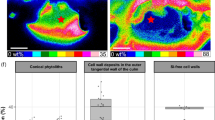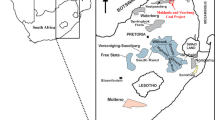Abstract
Garnet single crystals of several millimeters in diameter were collected from the uppermost horizon of a soil profile developing immediately on the gneissic rocks of the Vertiskos Unit of the Serbomacedonian Massif in northern Greece. The garnets were analyzed for major elements by EDS analyzer mounted on a scanning electron microscope, and the obtained data were utilized to determine their source rocks. Bivariate diagrams, spider diagrams as well as statistical analysis were used in order to correlate and compare the garnet composition of the basement rocks of the Vertiskos Unit with the existing reference data. This case study demonstrates the difficulty in assigning a source rock to sediment, using only the chemical compositional of detrital garnet. Direct linking of the detrital garnets and the outcropping rocks is not always possible despite well documented outcrop lithologies. This is largely due to a complex metamorphic evolution that leads to overlapping compositions between garnets originating from different lithologies that have undergone similar metamorphic processes and alteration effects.












Similar content being viewed by others
References
Blatt H, Middleton G, Murray R (1972) Origin of sedimentary rocks. Prentice-Hall, New Jersey
Blatt H, Tracy RJ, Owens BE (2006) Petrology: igneous, sedimentary and metamorphic, 3rd edn. W.H. Freeman and Co, New York
Chatzidimitriadis E, Tsirambides A, Theodorikas S (1993) Clay mineral abundance of shales and slates from some Greek regions through geologic time. Proc Acad Athens 68:144–161
Deer WA, Howie RA, Zussman J (1982) Rock–forming minerals, Orthosilicates. Longmans, London
Deer WA, Howie RA, Zussman J (1998) An introduction to the rock–forming minerals, 2nd edn. Addison Wesley, Essex
Di Giulio A, Tribuzio R, Ceriani A, Riccardi MP (1999) Integrated analyses constraining the provenance of sandstones, a case study: the Section Peak Formation (Beacon Supergroup, Antarctica). Sed Geol 124:169–183
Dickinson WR (1970) Interpreting detrital modes of greywacke and arkose. J Sed Petrol 40:695–707
Dimitriadis S, Godelitsas A (1991) Evidence for high pressure metamorphism in the Vertiskos Group of the Serbomacedonian Massif: The eclogite of Nea Roda, Chalkidiki. Bull Geol Soc Greece 25:67–80
Dixon JE, Dimitriadis S (1987) The metamorphic evolution of the Serbomacedonian Massif in Greece. Terra Cognita 7:106
Folk RL (1974) Petrology of sedimentary rocks. Hemphill Publishing, Austin
Garzanti E, Ando S (2007) Heavy mineral concentration in modern sands: implications for provenance interpretation. In: Mange MA, Wright DT (eds) Heavy minerals in use. Elsevier BV, Amsterdam, pp 517–545
Georgiadis IK, Koroneos A, Tsirambides A, Stamatakis M (2012) Modern sands derived from the Vertiskos Unit of the Serbomacedonian Massif (N. Greece): a preliminary study on the weathering of the Unit. Cent Eur J Geosci 4:465–477
Goncharov AG, Saltykova AK (2008) Iron valency in minerals of xenoliths and redox state of the upper mantle (by Mössbauer spectroscopy data). Hyperfine Interact 186:187–192
Harlov DE, Johansson L, van den Kerkhof A, Förster H-J (2006) The role of advective fluid flow and diffusion during localized, solid-state dehydration: Söndrum Stenhuggeriet, Halmstad, SW Sweden. J Petrol 47:3–33
Himmerkus F, Anders B, Reischmann T, Kostopoulos DK (2007) Gondwana-derived terranes in the northern Hellenides. In: Hatcher RD Jr, Carlson MP, McBride JH, Martínez-Catalán JR (eds) 4-D Framework of Continental Crust. Geological Society of America Memoir, Boulder, pp 379–390
Himmerkus F, Reischmann T, Kostopoulos D (2009) Serbo-Macedonian revisited: a Silurian basement terrane from northern Gondwana in the Internal Hellenides, Greece. Tectonophysics 471:20–35
Hunt GR, Salisbury JW, Lenhoff CJ (1973) Visible and near-infrared spectra of minerals and rocks: VI. Additional silicates. Mod Geol 4:85–106
I.G.M.E. (1978a) Sheet Thermi, Geological map of Greece, scale 1:50000. Athens
I.G.M.E. (1978b) Sheet Thessaloniki, Geological map of Greece, scale 1:50000. Athens
I.G.M.E. (1978c) Sheet Zangliverion, Geological map of Greece, scale 1:50000. Athens
I.G.M.E. (1979a) Sheet Kilkis, Geological map of Greece, scale 1:50000. Athens
I.G.M.E. (1979b) Sheet Lachanas, Geological map of Greece, scale 1:50000. Athens
I.G.M.E. (1979c) Sheet Sochos, Geological map of Greece, scale 1:50000. Athens
I.G.M.E. (1990) Sheet Herson, Geological map of Greece, scale 1:50000. Athens
Jolliffe IT (2010) Principal component analysis, 2nd edn. Springer, New York
Kassoli-Fournaraki A (1982) The origin of the Kerdyllia series amphibolites (eastern Serbomacedonian mass), Greece. Neues JB Miner 6:272–278
Kauffmann G, Kockel F, Mollat H (1976) Notes on the stratigraphic and palaeogeographic position of the Svoula Formation in the innermost zone of the Hellenides (Northern Greece). B Soc Geol Fr 18:225–230
Kilias A, Falalakis G, Mountrakis D (1999) Cretaceous-Tertiary structures and kinematics of the Serbomacedonian metamorphic rocks and their relation to the exhumation of the Hellenic hinterland (Macedonia, Greece). Int J Earth Sci 88:513–531
Knowles CR (1987) A BASIC program to recast garnet end members. Comput Geosci 13:655–658
Kockel F, Walther H (1965) Strimonline als Grenze zwischen Serbo-Mazedonischen und Rila-Rhodope Massiv in Ost-Mazedonien. Geol Jahr 83:575–602
Kockel F, Mollat H, Walther HW (1971) Geologie des Serbo-Mazedonischen Massivs und seines mesozoischen Rahmens (Nordgriechenland). Geol Jahr 89:529–551
Kockel F, Mollat H, Walther HW (1977) Erläuterungen zur geologischen Karte der Chalkidiki und angrenzender Gebiete 1:100 000 (Nord-Griechenland). Bundesanstalt für Geowissenschaften und Rohstoffe, Hannover
Kourou AN (1991) Lithology, geochemistry, tectonics and metamorphosis of a part of the Western part of Vertiskos group: The area NE of the Lake of Agios Vasilios (Koronia). Dissertation, Aristotle University of Thessaloniki (in Greek with English abstract)
Locock AJ (2008) An Excel spreadsheet to recast analyses of garnet into end-member components, and a synopsis of the crystal chemistry of natural silicate garnets. Comput Geosci 34:1769–1780
Marakis G (1969) Geochronology on granites of Macedonia. Annal Géol Pays Héllén 21:121–152 (in Greek with English abstract)
Meagher EP (1980) Silicate garnets. In: Ribbe PH (ed) Reviews in mineralogy, Orthosilicates, vol 5. Mineralogical Society of America, Washington DC, pp 25–65
Meinhold G (2007) Sedimentary rocks from the Internal Hellenides, Greece: age, source and depositional setting. Dissertation, Johannes Gutenberg-Universität
Meinhold G, Kostopoulos D, Frei D, Himmerkus F, Reischmann T (2010) U–Pb LA-SF-ICP-MS zircon geochronology of the Serbo-Macedonian Massif, Greece: Palaeotectonic constraints for Gondwana-derived terranes in the Eastern Mediterranean. Int J Earth Sci 99:813–832
Moore RK, White WB, Long TV (1971) Vibrational spectra of the common silicates: I. The garnets. Am Mineral 56:54–71
Morton AC (1987) Influences of provenance and diagenesis on detrital garnet suites in the Paleocene Forties Sandstone, central North Sea. J Sed Petrol 57:1027–1032
Morton AC, Hallsworth CR (1999) Processes controlling the composition of heavy minerals in sandstones. Sed Geol 124:3–29
Morton A, Allen M, Simmons M, Spathopoulos F, Still J, Hinds D, Ismail-Zadeh A, Kroonenberg S (2003) Provenance patterns in a neotectonic basin: Pliocene and Quaternary sediment supply to the South Caspian. Basin Res 15:321–337
Morton A, Hallsworth C, Chalton B (2004) Garnet compositions in Scottish and Norwegian basement terrains: a framework for interpretation of North Sea sandstone provenance. Mar Petrol Geol 21:393–410
Mountrakis D (2002) Tectonic evolution of the Hellenic orogen: geometry and kinematics of deformation. Bull Geol Soc Greece 34:2113–2126
Müntener O, Hermann J, Trommsdorff V (2000) Cooling history and exhumation of lower-crustal granulite and upper mantle (Malenco, Eastern Central Alps). J Petrol 41:175–200
Nandi K (1967) Garnets as indices of progressive regional metamorphism. Mineral Mag 36:89–93
Papadopoulos C (1982) Geologie des Serbomazedonischen Massivs nordlich des Volvi Sees (Nord Griecheland). University of Wien
Pavlides SB, Kondopoulou DP, Kilias AA, Westphal M (1988) Complex rotational deformations in the Serbo-Macedonian massif (north Greece): structural and paleomagnetic evidence. Tectonophysics 145:329–335
Pettijohn FJ, Potter PE, Siever R (1973) Sand and sandstone. Springer–Verlag, New York
Poli G, Christofides G, Koroneos A, Soldatos T, Perugini D, Langone A (2009) Early Triassic granitic magmatism–Arnea and Kerkini Granitic Complexes–in the Vertiskos Unit (Serbo-Macedoniam Massif, North-Eastern Greece) and its significance in the geodynamic evolution of the area. Acta Vulcanol 20–21:47–70
Psilovikos A (1977) Palaeogeographic evolution of the basin and the lake of Mygdonia (Lagada-Volvi). Dissertation, Aristotle University of Thessaloniki (in Greek with English abstract)
Psilovikos A (1984) Geomorphological and structural modification of the Serbomacedonian Massif during the neotectonic stage. Tectonophysics 110:27–45
R Core Team (2012) R: a language and environment for statistical computing: R Foundation for Statistical Computing, ISBN 3-900051-07-0, URL http://www.R-project.org/. Accessed 10 Jan 2013
Rickwood PC (1968) On recasting analyses of garnet into end-member molecules. Contr Mineral Petrol 18:175–198
Sidiropoulos Ν (1991) Lithology, geochemistry, tectonics and metamorphosis of the Northwestern part of Vertiskos group: The area of Mountain Disoro (Kroussia), North of Kilkis. Dissertation, Aristotle University of Thessaloniki (in Greek with English abstract)
Suggate SM, Hall R (2013) Using detrital garnet compositions to determine provenance: a new compositional database and procedure. In: Smyth H S, Morton A C (eds) Sediment provenance studies in hydrocarbon exploration and production. Geological Society of London Special Publication (in press)
Suttner LJ (1974) Sedimentary petrographic provinces: an evaluation. In: Ross CA (ed) Paleogeographic provinces and provinciality. Society for Sedimentary Geology, Tulsa, pp 75–84
Tracy RJ (1982) Compositional zoning and inclusions in metamorphic minerals. In: Ferry JM (ed) Reviews in mineralogy, characterization of metamorphism through mineral equilibria, vol 10. Mineralogical Society of America, Washington DC, pp 355–397
Veranis N, Kougoulis C, Kassoli-Fournaraki A (1990) The Examili formation and its relation to the Vertiskos subzone of the Serbomacedonian massif. Bull Geol Soc Greece 22:71–86
Voidomatis PS, Pavlides SB, Papadopoulos GA (1990) Active deformation and seismic potential in the Serbomacedonian zone, northern Greece. Tectonophysics 179:1–9
Win KS, Takeuchi M, Tokiwa T (2007) Changes in detrital garnet assemblages related to transpressive uplifting associated with strike-slip faulting: An example from the Cretaceous System in Kii Peninsula, Southwest Japan. Sed Geol 201:412–431
Woodsworth GJ (1977) Homogenization of zoned garnets from pelitic schists. Can Mineral 15:230–242
Zagorchev I (2007) Late Cenozoic development of the Strouma and Mesta fluviolacustrine systems, SW Bulgaria and Northern Greece. Quaternary Sci Rev 26:2783–2800
Zervas SA (1980) Geochronology with the 87Rb-87Sr method of some pegmatite samples from the area of Lagada. Annal Géol Pays Héllén 30:143–153 (in Greek with English abstract)
Acknowledgments
The first author would like to thank the technicians G. Michailidis, D. Katsikas and the geologist N. Kipouros for the preparation of the thin sections. The first author is also grateful to the Research Committee of the Aristotle University of Thessaloniki for the financial aid. The critical remarks of the anonymous reviewers are thankfully acknowledged.
Author information
Authors and Affiliations
Corresponding author
Additional information
Editorial handling: J. Kosler
Rights and permissions
About this article
Cite this article
Georgiadis, I.K., Koroneos, A., Papadopoulou, L. et al. Using detrital garnets to determine provenance: a case study from the Vertiskos Unit (Serbomacedonian Massif, N. Greece). Miner Petrol 108, 187–206 (2014). https://doi.org/10.1007/s00710-013-0295-1
Received:
Accepted:
Published:
Issue Date:
DOI: https://doi.org/10.1007/s00710-013-0295-1




